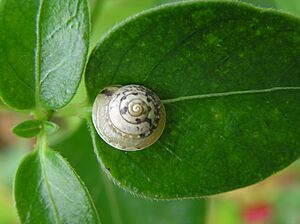Hygromia cinctella facts for kids
Quick facts for kids Hygromia cinctella |
|
|---|---|
 |
|
| A live girdled snail, pulled into its shell | |
| Conservation status | |
| Scientific classification | |
| Genus: |
Hygromia
|
| Species: |
cinctella
|
| Synonyms | |
|
List
|
|
The Hygromia cinctella, commonly called the girdled snail, is a small snail that breathes air and lives on land. It is a type of gastropod mollusk, related to slugs and other snails. This snail is originally from the Mediterranean area in Europe. A French scientist named Jacques Draparnaud first described it in 1801. Today, you can find it in many parts of central and northern Europe.
Contents
What Does the Girdled Snail Look Like?
The girdled snail has a shell that is about 6–7 mm tall and 10–12 mm wide. Its shell usually spirals to the right, which is called dextral. The shell has 5 to 6 turns, or whorls, that stack up to form a tall, cone-shaped top. The bottom of the shell is flat.
Shell Features
The last whorl of the shell has a sharp ridge, called a keel. This keel has a special white edge that looks like a belt or "girdle" around the shell. This is how the snail got its common name. The opening of the shell, called the aperture, is simple and does not have a thick lip inside.
The center hole on the underside of the shell, known as the umbilicus, is very narrow. It is almost completely covered by the shell's edge near the opening. The shell's color can change a lot. It might be whitish-grey, light brown, or even have dark spots. The shell is a bit see-through and has fine, regular lines on it.
Snail's Body
The snail's body is usually light grey or yellowish. Its head and tentacles are often a darker grey or brownish color. In some places, like Sicily, you can find snails with green, yellow, or reddish shells, sometimes with color bands.
Where Does the Girdled Snail Live?
This snail is originally from several European countries around the Mediterranean Sea. These include southeastern France, southern Switzerland, northwestern Croatia, Italy, and Slovenia.
Spread to New Areas
The girdled snail has been accidentally moved to many new places. It is now quickly settling in countries like Great Britain, Austria, the Czech Republic, Hungary, Belgium, Germany, the Netherlands, and even the United States. It has also been found in Ireland.
In Britain, the snail was first noticed in 1945 but was misidentified. It was officially described as new to Britain in 1950. For a long time, it mostly stayed in southeastern England. However, since the mid-1970s, it has spread much more widely. You can now find it in many scattered locations, even as far north as Scotland. The first record in Scotland was in Glasgow in 2008. In Britain, these snails seem to prefer places changed by humans, like gardens, hedgerows, and empty lots.
In Ireland, the girdled snail has been found in two places: an empty lot near Cork City and a garden near Lisburn. The snails in the garden likely arrived by accident with garden plants brought from a place near Bristol.
How the Girdled Snail Behaves
Girdled snails often gather together in large groups. They are active at night when it is humid, moving on paths and flat stones. During the day, they might rest high on walls or hide in leaf litter and under logs.
Activity in Cold Weather
These snails can be active even in cold weather. They can survive very cold winters in Central Europe. This suggests that their recent spread might be more due to people moving them around (like on plants) rather than changes in the climate.
Reproduction and Love Darts
When these snails mate, they use special structures called love darts. These darts are used as part of their mating behavior.
Images for kids







